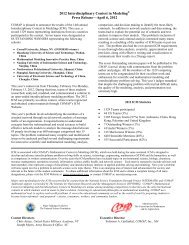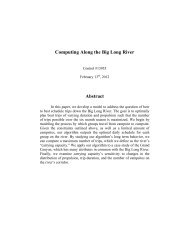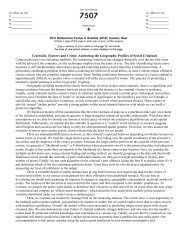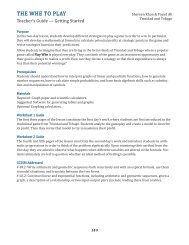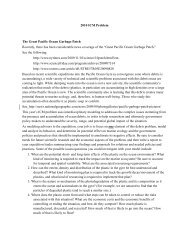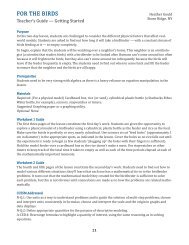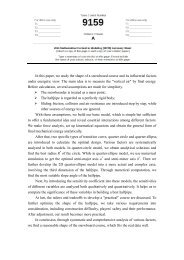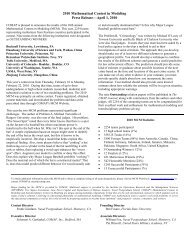Team 13074: Best schedule to utilize the Big Long River
Team 13074: Best schedule to utilize the Big Long River
Team 13074: Best schedule to utilize the Big Long River
Create successful ePaper yourself
Turn your PDF publications into a flip-book with our unique Google optimized e-Paper software.
team<strong>13074</strong><br />
page 2of20<br />
(1) “optimal”: it means <strong>to</strong> best <strong>utilize</strong> all <strong>the</strong> campsites and maximize <strong>the</strong> <strong>to</strong>tal<br />
number of trips in a six months period.<br />
(2) “route”: it means <strong>the</strong> campsites at which <strong>to</strong>urists choose <strong>to</strong> s<strong>to</strong>p in a given trip.<br />
(3) “orbit”: it means a specific campsite set that allows some certain trip types <strong>to</strong><br />
travel in.<br />
(4) For better description we assign a natural number <strong>to</strong> every campsite in <strong>the</strong><br />
downstream direction, from 0 <strong>to</strong> Y+1.<br />
(5) For better description we assign a natural number <strong>to</strong> every trip type, from 1 <strong>to</strong> 26,<br />
as shown in <strong>the</strong> following chart.<br />
6 7 8 9 10 11 12 13 14 15 16 17 18<br />
Oar-powered 1 3 5 7 9 11 13 15 17 19 21 23 25<br />
Mo<strong>to</strong>rized 2 4 6 8 10 12 14 16 18 20 22 24 26<br />
Chart1 The numbered list of trip types<br />
(6) We use A i <strong>to</strong> denote <strong>the</strong> average time <strong>to</strong>urists travel per day for a certain trip<br />
type i.<br />
(7) We use n i <strong>to</strong> denote <strong>the</strong> number of campsites in every orbit corresponding <strong>to</strong><br />
trip type i.<br />
(8) We use m i <strong>to</strong> denote <strong>the</strong> number of trips in a six months period for a certain<br />
trip type i.<br />
3 Specific formulation of problem<br />
We denote <strong>the</strong> river and <strong>the</strong> campsites along it using a straight segment with Y<br />
uniformly distributed points in it. Time is measured in day units. The <strong>to</strong>tal time<br />
period is 180 days (six months). Passengers choose <strong>to</strong> stay at a different point every<br />
day downstream <strong>the</strong> segment. Here our paper will focus on three sub questions.<br />
In part 1, passengers have <strong>to</strong> travel along <strong>the</strong> rigid route set by river agency, so <strong>the</strong><br />
problem should be <strong>to</strong> come up with <strong>the</strong> <strong>schedule</strong> <strong>to</strong> arrange for <strong>the</strong> maximum<br />
number of trips without occurrence of two different trips occupying <strong>the</strong> same<br />
campsite on <strong>the</strong> same day.<br />
In part 2, passengers have <strong>the</strong> freedom <strong>to</strong> choose which campsites <strong>to</strong> s<strong>to</strong>p at,<br />
<strong>the</strong>refore <strong>the</strong> ma<strong>the</strong>matical description of <strong>the</strong>ir actions inevitably involve<br />
randomness and probability, and we actually use a probability model. The next<br />
campsite passengers choose at a current given campsite is subject <strong>to</strong> a certain<br />
distribution, and we describe events of two trips occupying <strong>the</strong> same campsite by<br />
probability. Note in probability model it is no longer appropriate <strong>to</strong> say that two tri ps<br />
do not meet at a campsite with certainty; instead, we regard events as impossible if<br />
<strong>the</strong>ir probabilities are below an adequately small number. Then we try <strong>to</strong> find <strong>the</strong><br />
optimal <strong>schedule</strong>.<br />
In part 3, passengers have <strong>the</strong> freedom <strong>to</strong> choose both <strong>the</strong> type and route of <strong>the</strong> trip;<br />
<strong>the</strong>refore a probability model is also necessary. We continue <strong>to</strong> adopt <strong>the</strong> probability<br />
description as in part 2 and <strong>the</strong>n try <strong>to</strong> find <strong>the</strong> optimal <strong>schedule</strong>.<br />
4 Assumptions<br />
We make following assumptions:







